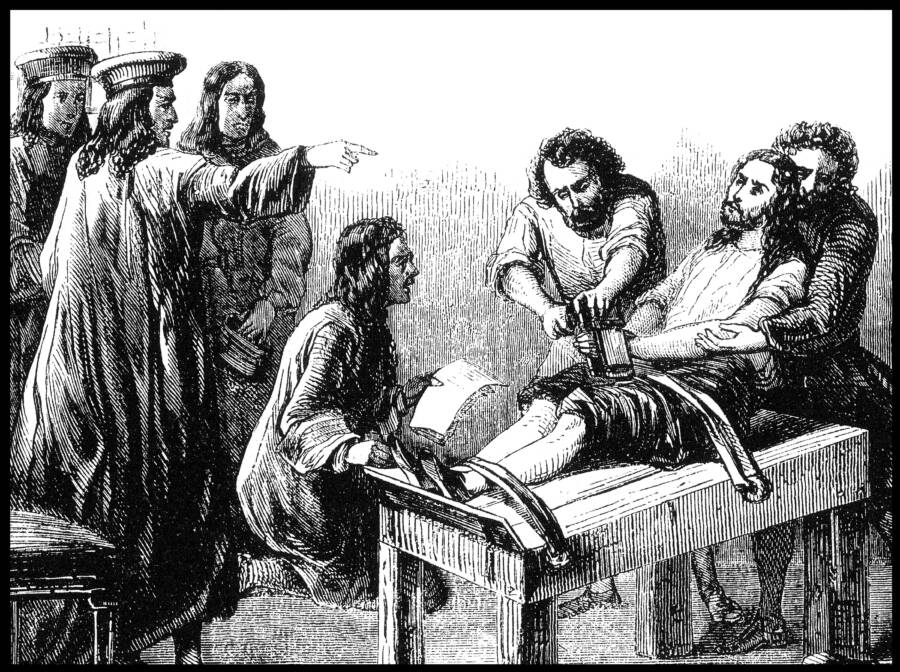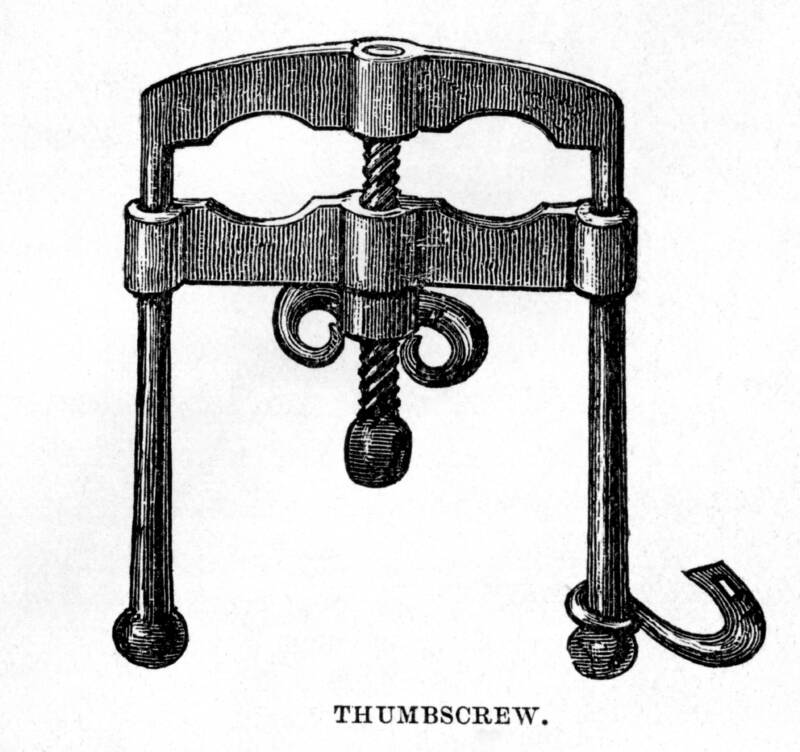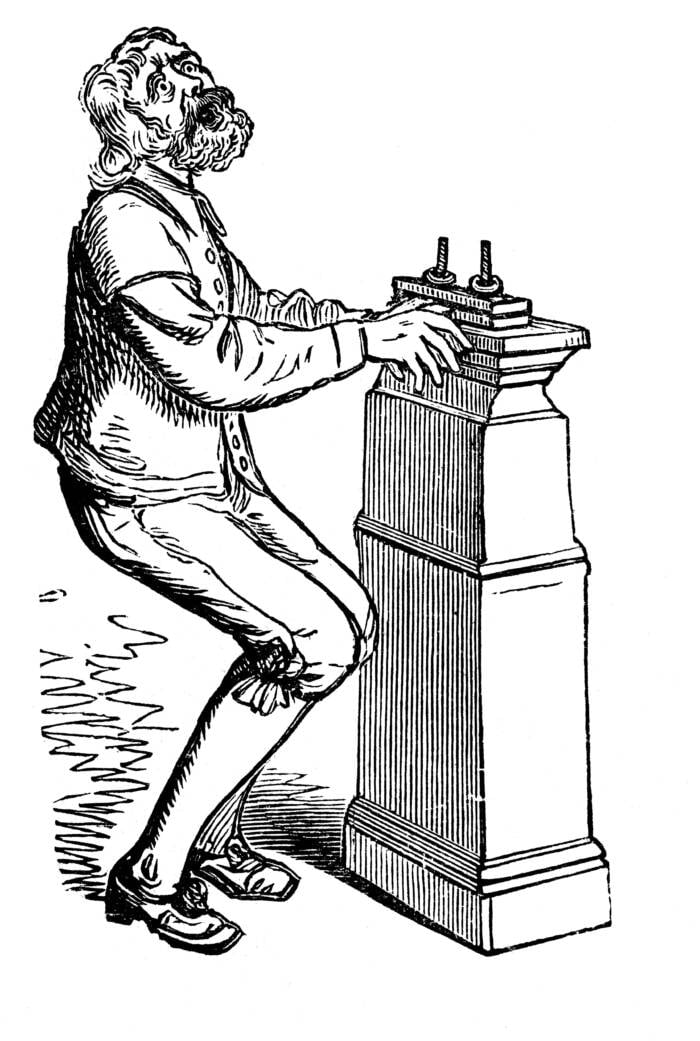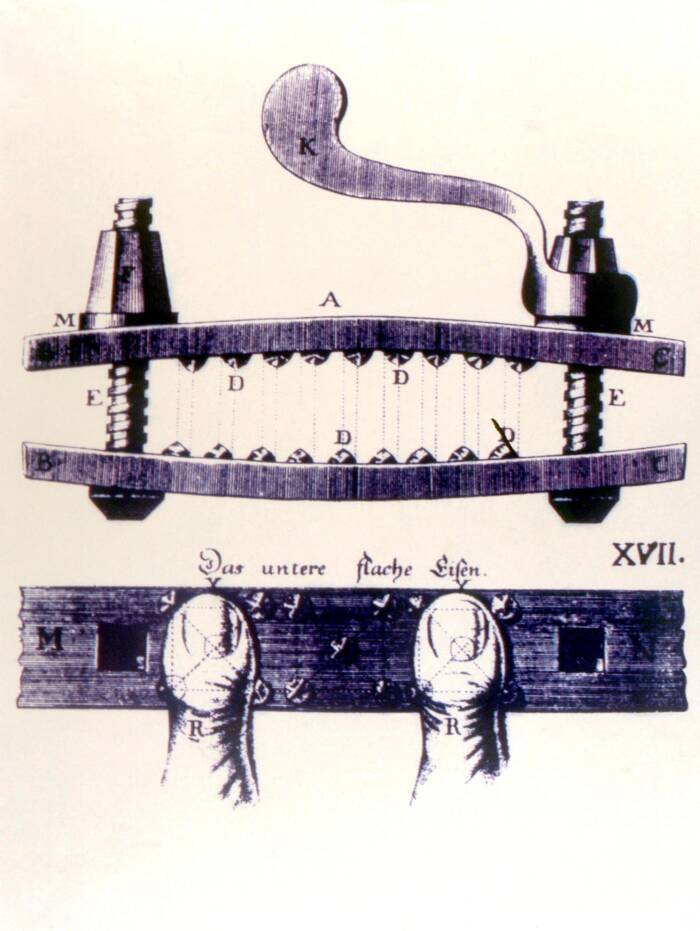A torture device commonly used to elicit prisoner confessions in early modern Europe, the thumbscrew was designed to crush victims’ fingers or toes, leaving them in incredible pain — but alive.

Science History Images / Alamy Stock PhotoThe thumbscrew is a torture instrument first used in medieval Europe to crush prisoners’ thumbs or big toes.
Throughout history, monarchs, armies, and religious organizations have employed any means necessary to maintain power. Often, this included torturing suspects with a variety of cruel and unusual devices to extract confessions. Many of these devices, such as the breaking wheel, seem barbaric by modern standards. Others were much more complex, like the Persian torture method of scaphism.
But torturers eventually learned that, sometimes, the most straightforward tortures were the most effective. Enter the thumbscrew, a simple vise introduced in Europe sometime during the early modern period.
This torture instrument was fairly rudimentary in its design — but that didn’t mean it couldn’t get the job done. Often, as the name would suggest, the thumbscrew was so small as to only fit a person’s thumbs or big toes. After being placed around a victim’s digits, it would be slowly tightened, crushing the appendages beneath an iron bar.
There were variations, however. Sometimes, a thumbscrew could fit five fingers at once, or all 10 toes. Other times, the metal bars were lined with sharp points that stabbed into the body. In every circumstance, though, one thing was certain: It was incredibly painful.
Where Did The Thumbscrew Originate?
Also known as the “thumbkin” or the “pilniewink,” the thumbscrew has a murky history. One of the most prominent descriptions of the thumbscrew comes from historians James Cochrane and John McCrone, who, in an 1833 analysis of the writings of Sir Walter Scott, wrote:
“Thus we read, that in 1596, the son and daughter of Aleson Balfour, who was accused of witchcraft, were tortured before her to make her confess her crime in the manner following: Her son was put in the buits where he suffered fifty seven strokes; and her daughter about seven years old, was put in the pilniewinks.”
Cochrane and McCrone suggested that the thumbscrew had made its way to Britain sometime around the 16th century, perhaps when the Spanish Armada invaded. However, other historians have posited alternative theories regarding the thumbscrew’s origins.

Science History Images / Alamy Stock PhotoA 17th-century illustration of a thumbscrew torture device.
For example, some scholars have argued that the thumbscrew originated in Russia, where it was used on personnel of the Russian Army as a punishment for misbehaving.
In either case, the thumbscrew eventually made its way to mainland Europe, where it was implemented as a torture device used to elicit confessions from those presumed to be guilty of various crimes, or to extract information about the torturer’s rivals.
In one infamous case, it was even used as a method to corroborate claims during a criminal trial. In the early 17th century, the famed Italian artist Artemisia Gentileschi was tortured in court after she accused her tutor, Agostino Tassi, of raping her. Tassi’s defense was that Artemisia was “an insatiable whore.” But even while she was being tortured by a thumbscrew, Artemisia was unwavering, telling the court, “It is true, it is true, it is true, it is true.”
How Does It Work?
As George Everett Hussey Macdonald explains in his 1894 treatise Thumbscrew and Rack, the typical thumbscrew was made up of two flat pieces of iron held together by upright metal rods. One of the bars had holes on either end so that it could move up and down the metal rods with the turn of a screw, which was set in between the rods.
The victim’s appendages were placed between the iron bars as a torturer turned the screw, tightening the bars around the victim’s fingers or toes until they were crushed.
Naturally, the pain was agonizing — and intensified the more the torturer turned the screw. Someone could tighten the thumbscrew quickly or slowly. An interrogator might squeeze someone’s thumbs tightly to give them a taste of the pain they will experience, wait for several minutes, then make slow turns after that.

Science History Images / Alamy Stock PhotoA 1912 wood engraving of thumbscrew torture.
Eventually, the thumbscrew could cause the victim’s bones to break and their tendons to tear. The absolute agony made the thumbscrew one of the most effective torture devices in history.
Unlike some torture devices, the end-goal wasn’t death — just unbelievable pain. Sometimes, the bars were even lined with sharp points that stabbed into the victim’s digits as they were crushed.
The thumbscrew was frequently used in prisons to torture confessions out out of suspected criminals. However, because these devices were fairly small, they were portable — and could be used anytime, anywhere.
In fact, until the 19th century, enslavers in the Atlantic slave trade made frequent use of thumbscrews to subdue leaders of slave revolts who tried to take over ships making the crossing from Africa to America.
The Lasting Effects Of Thumbscrew Torture
The thumbscrew did more than just inflict pain in the moment; it often left victims with lasting damage that could alter the course of their life.
For example, opposable thumbs were necessary to properly grip things like bows, arrows, swords, and the reins of horses. It was theoretically possible to function without thumbs, but if a person’s thumbs were damaged, it made it much more difficult to handle everyday implements. Even things as simple as using a hoe or opening a door needed to be approached in a completely new way.
Deformed thumbs could also make it easier for inquisitors to recognize people they’d tortured in the past. It also guaranteed that tortured people who reported back to their fellows would demonstrate to them that their enemies meant business.

Charles Walker Collection / Alamy Stock PhotoA detailed illustration highlighting various parts of a thumbscrew.
But these devices weren’t solely used on thumbs. Often, torturers would use thumbscrews on other parts of the body, including big toes. Big toes are, notably, crucial for maintaining balance, bearing a significant portion of the weight when someone walks — 40 percent, in fact.
Causing damage to a person’s big toe could forever affect their gait. To make matters worse, big toes are loaded with nerves — which just made the crushing torture even more painful.
The same design was also adapted to be used on larger parts of the body, including arms, legs, and even the head.
In any case, the thumbscrew was painful, slow, and agonizing torture. Victims probably didn’t sleep very much due to the pain, which made them even more susceptible to letting the truth slip out during a confession.
Of course, it’s also likely that some confessors gave false confessions to try and avoid torture altogether.
So, the next time someone says “You’re screwed,” think about the thumbscrew. Then, hide your thumbs.
After learning about the thumbscrew torture method, check out some of the worst ways to die. Then, read about the Pear of Anguish, which was quite possibly the worst of them all.





